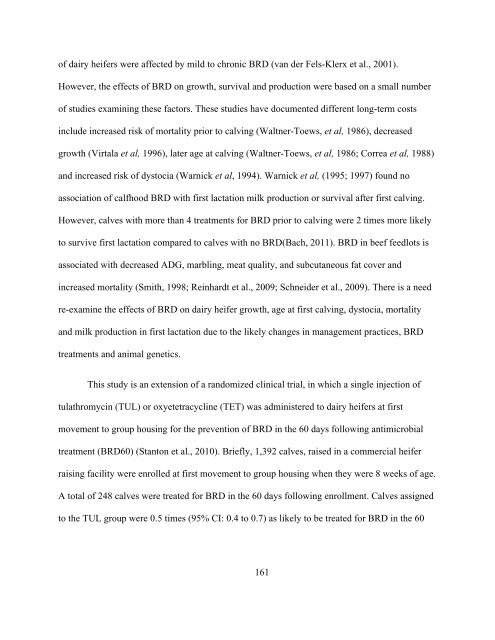Stanton PhD Thesis final_docx - Atrium - University of Guelph
Stanton PhD Thesis final_docx - Atrium - University of Guelph
Stanton PhD Thesis final_docx - Atrium - University of Guelph
Create successful ePaper yourself
Turn your PDF publications into a flip-book with our unique Google optimized e-Paper software.
<strong>of</strong> dairy heifers were affected by mild to chronic BRD (van der Fels-Klerx et al., 2001).<br />
However, the effects <strong>of</strong> BRD on growth, survival and production were based on a small number<br />
<strong>of</strong> studies examining these factors. These studies have documented different long-term costs<br />
include increased risk <strong>of</strong> mortality prior to calving (Waltner-Toews, et al, 1986), decreased<br />
growth (Virtala et al, 1996), later age at calving (Waltner-Toews, et al, 1986; Correa et al, 1988)<br />
and increased risk <strong>of</strong> dystocia (Warnick et al, 1994). Warnick et al, (1995; 1997) found no<br />
association <strong>of</strong> calfhood BRD with first lactation milk production or survival after first calving.<br />
However, calves with more than 4 treatments for BRD prior to calving were 2 times more likely<br />
to survive first lactation compared to calves with no BRD(Bach, 2011). BRD in beef feedlots is<br />
associated with decreased ADG, marbling, meat quality, and subcutaneous fat cover and<br />
increased mortality (Smith, 1998; Reinhardt et al., 2009; Schneider et al., 2009). There is a need<br />
re-examine the effects <strong>of</strong> BRD on dairy heifer growth, age at first calving, dystocia, mortality<br />
and milk production in first lactation due to the likely changes in management practices, BRD<br />
treatments and animal genetics.<br />
This study is an extension <strong>of</strong> a randomized clinical trial, in which a single injection <strong>of</strong><br />
tulathromycin (TUL) or oxyetetracycline (TET) was administered to dairy heifers at first<br />
movement to group housing for the prevention <strong>of</strong> BRD in the 60 days following antimicrobial<br />
treatment (BRD60) (<strong>Stanton</strong> et al., 2010). Briefly, 1,392 calves, raised in a commercial heifer<br />
raising facility were enrolled at first movement to group housing when they were 8 weeks <strong>of</strong> age.<br />
A total <strong>of</strong> 248 calves were treated for BRD in the 60 days following enrollment. Calves assigned<br />
to the TUL group were 0.5 times (95% CI: 0.4 to 0.7) as likely to be treated for BRD in the 60<br />
161

















